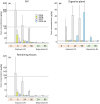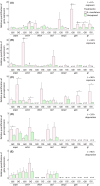Sublethal exposure of eastern oyster Crassostrea virginica to the goniodomin-producing dinoflagellate Alexandrium monilatum: Fate of toxins, histopathology, and gene expression
- PMID: 39739761
- PMCID: PMC11685061
- DOI: 10.1002/aah.10227
Sublethal exposure of eastern oyster Crassostrea virginica to the goniodomin-producing dinoflagellate Alexandrium monilatum: Fate of toxins, histopathology, and gene expression
Abstract
Objective: The dinoflagellate Alexandrium monilatum forms blooms during summer in tributaries of the lower Chesapeake Bay. Questions persist about the potential for A. monilatum to negatively affect aquatic organisms. Its main toxin, goniodomin A (GDA), a polyketide macrolide, has been shown to have adverse effects on animals, for example through cytotoxicity and interaction with actin.
Methods: Eastern oysters Crassostrea virginica were exposed for 96 h to sublethal concentrations of A. monilatum (615 ± 47 cells/mL [average ± SD]; containing mainly intracellular GDA [215 ± 7.15 pg/cell] and to a lesser extent goniodomin B, goniodomin C, and GDA seco-acid as quantified by liquid chromatography coupled to tandem mass spectrometry) or to nontoxic phytoplankton or were unexposed. They were subsequently depurated for 96 h by exposure to nontoxic phytoplankton. Clearance rates were estimated, and oysters were sampled daily and tissue (gill, digestive gland, and remaining tissues) excised for analyses by histopathology, gene expression quantified by quantitative PCR, and goniodomin quantification.
Result: A positive clearance rate, no mortality, and no tissue pathologies were observed in oysters exposed to A. monilatum. Goniodomin A was detected in gill 6 h after exposure (504 ± 329 μg/kg [average ± SE]) and to a lesser extent in the digestive gland and remaining soft tissues. In the digestive gland, a trend of transformation of GDA to GDA seco-acid was observed. The majority of toxins (≥83%) were depurated after 96 h. Expression of genes involved in oxidative response increased 14-fold after 6 h, and those involved in actin synthesis showed a 27-fold change after 24 h, while expression of apoptosis genes increased 6.9-fold after 96 h compared with the control (eastern oysters exposed to nontoxic phytoplankton).
Conclusion: Exposure experiments (nonsublethal or chronic) should be carried out to better assess the threat of this species and toxins for eastern oysters and other marine organisms.
Keywords: Alexandrium monilatum; Crassostrea virginica; apoptosis; bivalve mollusks; dinoflagellates; fate of toxins; goniodomin metabolism; goniodomins; oxidative stress.
© 2024 The Author(s). Journal of Aquatic Animal Health published by Wiley Periodicals LLC on behalf of American Fisheries Society.
Conflict of interest statement
Authors declare no conflicts of interest.
Figures


Similar articles
-
Investigating the role of allelochemicals in the interaction between Alexandrium monilatum and other phytoplankton species.Harmful Algae. 2024 Nov;139:102706. doi: 10.1016/j.hal.2024.102706. Epub 2024 Aug 16. Harmful Algae. 2024. PMID: 39567060
-
Metabolomic Investigations of the Temporal Effects of Exposure to Pharmaceuticals and Personal Care Products and Their Mixture in the Eastern Oyster (Crassostrea virginica).Environ Toxicol Chem. 2020 Feb;39(2):419-436. doi: 10.1002/etc.4627. Epub 2020 Jan 15. Environ Toxicol Chem. 2020. PMID: 31661721 Free PMC article.
-
[Volume and health outcomes: evidence from systematic reviews and from evaluation of Italian hospital data].Epidemiol Prev. 2013 Mar-Jun;37(2-3 Suppl 2):1-100. Epidemiol Prev. 2013. PMID: 23851286 Italian.
-
Immediate and delayed effects of a heatwave and Prorocentrum lima ((Ehrenberg) Stein 1878) bloom on the toxin accumulation, physiology, and survival of the oyster Magallana gigas (Thunberg, 1793).Sci Total Environ. 2023 Sep 20;892:164485. doi: 10.1016/j.scitotenv.2023.164485. Epub 2023 May 29. Sci Total Environ. 2023. PMID: 37257593
-
The Black Book of Psychotropic Dosing and Monitoring.Psychopharmacol Bull. 2024 Jul 8;54(3):8-59. Psychopharmacol Bull. 2024. PMID: 38993656 Free PMC article. Review.
References
-
- Abdullah, N. , Teng, S. T. , Hanifah, A. H. , Law, I. K. , Tan, T. H. , Krock, B. , Harris, T. M. , Nagai, S. , Lim, P. T. , Tillmann, U. , & Leaw, C. P. (2023). Thecal plate morphology, molecular phylogeny, and toxin analyses reveal two novel species of Alexandrium (Dinophyceae) and their potential for toxin production. Harmful Algae, 127, Article 102475. 10.1016/j.hal.2023.102475 - DOI - PubMed
-
- Aráoz, R. , Barnes, P. , Séchet, V. , Delepierre, M. , Zinn‐Justin, S. , Molgó, J. , Zakarian, A. , Hess, P. , & Servent, D. (2020). Cyclic imine toxins survey in coastal European shellfish samples: Bioaccumulation and mode of action of 28‐O‐palmitoyl ester of pinnatoxin‐G. first report of portimine‐A bioaccumulation. Harmful Algae, 98, Article 101887. 10.1016/j.hal.2020.101887 - DOI - PMC - PubMed
-
- Balech, E. (1995). The genus Alexandrium Halim (Dinoflagellata) . Sherkin Island Marine Station.
Publication types
MeSH terms
Substances
Grants and funding
LinkOut - more resources
Full Text Sources

